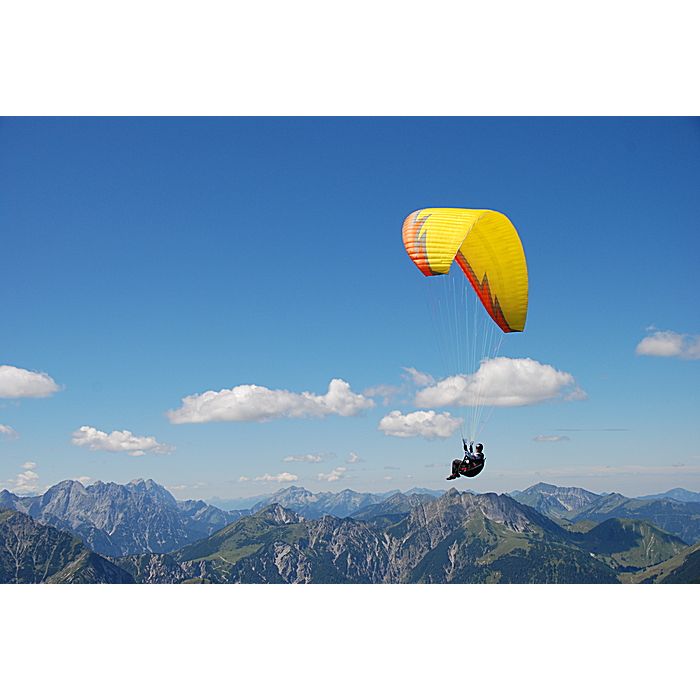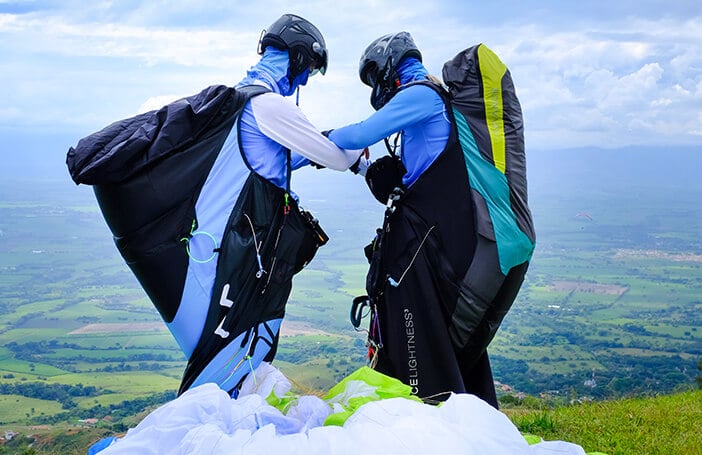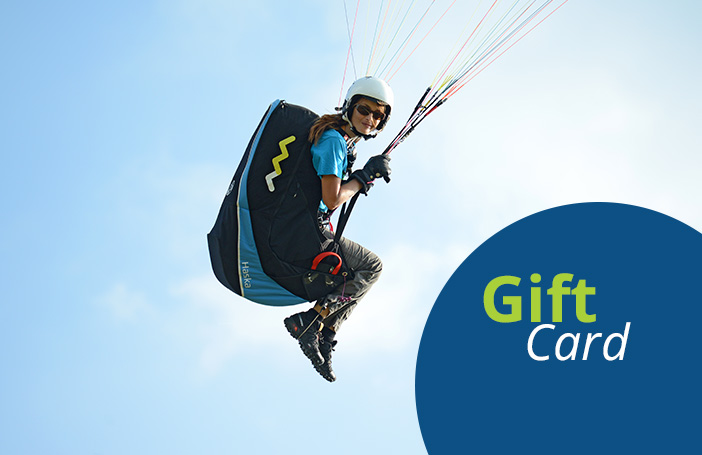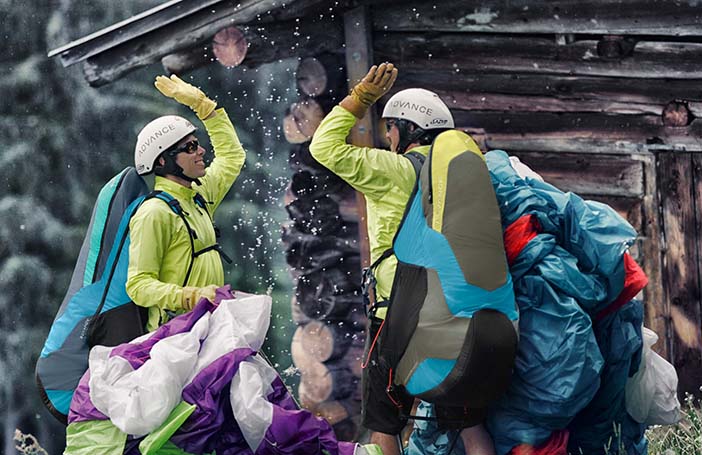
Nova Mentor 2 (PAST MODEL)
Select all options to view stock availability

Technical data
Nova Mentor 2 |
||||||
| Size: | XXS | XS | S | M | L | |
| Zoom factor | 0.880 | 0.930 | 0.970 | 1.010 | 1.050 | |
| No of cells | 51 | 51 | 51 | 51 | 51 | |
| Projected wingspan | m | 8.46 | 8.90 | 9.32 | 9.72 | 10.11 |
| Projected surface area | m² | 18.36 | 20.33 | 22.30 | 24.26 | 26.21 |
| Projected aspect ratio | 3.90 | 3.90 | 3.90 | 3.90 | 3.90 | |
| Flat wingspan | m | 10.86 | 11.42 | 11.96 | 12.48 | 12.97 |
| Flat surface area | m² | 21.68 | 24.00 | 26.33 | 28.65 | 30.96 |
| Flat aspect ratio | 5.43 | 5.43 | 5.43 | 5.43 | 5.43 | |
| Line diameter | mm | 0.6 / 0.7 / 0.8 / 1.3 | 0.6 / 0.7 / 0.8 / 1.3 | 0.6 / 0.7 / 0.8 / 1.3 | 0.6 / 0.7 / 0.8 / 1.3 | 0.6 / 0.7 / 0.8 / 1.3 |
| Line length | m | 6.27 | 6.60 | 6.91 | 7.21 | 7.49 |
| Line consumption | m | 224 | 235 | 247 | 258 | 268 |
| Max. profile depth | m | 2.49 | 2.60 | 2.72 | 2.84 | 2.95 |
| Min. profile depth | m | 0.62 | 0.65 | 0.68 | 0.71 | 0.74 |
| Weight | kg | 5.2 | 5.4 | 5.7 | 6.0 | 6.3 |
| Legal take-off weight | kg | 60-80 | 70-90 | 80-100 | 90-110 | 100-130 |
| take-off weight motor | kg | - | - | - | - | - |
| Places | 1 | 1 | 1 | 1 | 1 | |
| Certification | EN | (pending B) | B | B | B | B |
Colours
The Mentor 2 comes in four standard colours:
- Red Apple (Grey-White-Red)
- Sunrise (Orange-Grey-Yellow)
- Mojito (White-Orange-Green)
- Blue Moon (Grey-Orange-Dark Blue)
Nova Mentor 2
Development and design:
The development of the Mentor 2 was characterised by extensive computer simulations, with lots of testing and by many glide comparisons to check and to improve the performance.
The result is a fundamentally advanced glider. The planform of the new glider stayed the same as the Mentor 1, but we have increased the curvature for more stability and better handling characteristics. Further more we have completely changed the airfoil and the line setup: The Mentor 2 has just three line levels with a short split at the trailing edge in the centre of the wing for better handling characteristics.
Besides these changes, we have implemented many new details, like the miniribs at the trailing edge, and the polyamide rods at leading edge instead of mylar reinforcements for a better surface finish.
Despite all these changes we decided to keep the name “Mentor” and simply call the new glider “Mentor 2” to keep our model range clearer.
Flying the Mentor 2:
The short lines, the light canopy and the polyamide rods at the leading edge make it very easy to launch the Mentor 2 in various conditions.
To improve the handling characteristics we were looking for a balance between the Mentor 1 and the Factor. The result is a very agile and lively glider, which offers enough pitch and roll stability to relax the pilot during long flights, as well as in turbulent conditions.
The brake pressure is rather small and you can fly the Mentor 2 with little brake travel efficiently in thermals. One reason for the easy handling characteristics is the small projected aspect ratio. (Even less than on the Mentor 1) This makes it less tricky to control the glider in demanding conditions.
We were also taking a lot of care with the behaviour in accelerated flight. The pressure on the speed bar is very light and the wing increases speed efficiently. Combined with the high stability, it is very comfortable to use the whole speed range of the Mentor 2.
Safety:
We spent a lot of time to test the Mentor 2 in practical conditions. We couldn't think of a better place than our main testing site - the Rofan. It is known for its bumpy lee-thermals and for its strong valley winds during the summer months.
In these conditions the Mentor 2 stands out thanks to its high stability. If a collapse occurs, it tends to be quite small and the reopening occurs without impulsiveness. The long available brake travel and the increasing brake pressure helps to avoid an unintended stall when counter braking after a collapse.
The small aspect ratio makes cravats very unlikely.
The overall behaviour of the Mentor 2 is easy to manage and very predictable for pilots with some experience.
We recommend to all Mentor 2 pilots to test the behaviour after collapses themselves (during an SIV) to get their own impression.
Performance:
The Mentor 2 continues an impressive streak: Since the Thermik Magazine started to measure the glide ratio, there was always a Nova glider on top of the EN B Segment and it always stayed on top until it was outperformed by its successor. All those gliders could prove their performance in practical conditions with big success in various online XC-contests. We are talking about the Artax, the Mamboo and about the Mentor 1, which is still unbeaten in the “B” segment.
Until now: The Mentor 2 outperforms the Mentor 1 by far. We realised already with the very first prototypes of the Mentor 2 that it was pointless to do the glide comparisons with the Mentor 1, because the difference was too big. So we traded the Mentor 1 for a Triton (EN D) which then was our reference during the whole development process. Finally the Mentor 2 reached the Tritons performance with even slight advantages for the Mentor 2!
Especially in accelerated flight this is a huge improvement in the “B” class and it is the biggest performance increase we have ever reached!
Accelerated glide performance doesn’t help a lot if the glider is not stable enough to fly through bumpy air without collapses. The Mentor 2 excels in such conditions and cuts through turbulence with high pitch stability. Due to the small operating forces of the speed system it is easy to perform pitch corrections if necessary.
- increased curvature: more stability of the wing and better handling characteristics.
- shorter lines: better take-off behaviour and a better feeling for the glider during flight.
- new airfoil: because of the three line levels we needed a new airfoil. It stands out for its pitch stability, the big brake travel and a high collapse resistance.
- miniribs at the trailing edge: Those ribs help to increase the surface finish and thereby increase the performance.
- new suspension: The Mentor 2 has just three suspension levels and less attachment points at each line level. This leads to more than 30% less drag!
- Integrated vector band: Like on the FACTOR and TRITON we use an integrated vector band on the bottom sail at the cell openings to maximise the dimensional stability in this critical area.
- integrated polyamide rods: These very sturdy rods replace the mylar reinforcements and lead to less weight and more stability. The rods don’t need anymore care than the mylar reinforcements did!
Pilot's Profile
The MENTOR 2 is a high performance intermediate glider. It is not suited for Beginners. We recommend the glider for pilots who are already capable of certain techniques, like controlling a glider in turbulent conditions: The pilot should be able to prevent unwanted pitch or roll movement in bumpy air. If the pilot enters a strong thermal, he should intuitionally release the brakes to stop the glider from pitching backwards. When flying into sinking air, the pilot should apply more brakes.
The MENTOR 2 pilot should also be able to easily fly steep turns without unwanted pendulum movement. We think, that a pilot, who is not capable of those basic techniques will not be able to use the huge performance potential of the MENTOR 2.
We recommend to permanently work on your flying skills, by attending a SIV course, by training take-offs an a training hill or by ground handling the glider. All this will help you, to get a better understanding of your glider and to become a better pilot.
Every pilot, who flies on their own has to be able to decide if their skills and equipment is adequate for the respective conditions. The MENTOR 2 offers a high level of safety, but misjudgements may still have serious consequences.
The best way to avoid misjudgements is a defensive approach to the sport. Some times it makes sense to pass on a flight, instead of getting yourself into conditions you cannot handle. Regular training improves your skills and enables you to enjoy your flights, even in more difficult conditions.
Please consider these thoughts!
LTF/EN test reports:
Mentor 2 XS, Mentor 2 S, Mentor 2 M, Mentor 2 L
Manual
Nova Mentor 2 Manual - English (703.24 KB)
| Condition | New |
|---|---|
| EN Certification | EN B |
| LTF Certification | LTF B |
| Model Status | Past model |
Standard UK delivery - £3.95 / FREE on orders over £100.
Outside the UK - delivery calculated at checkout (based on the total order value and your delivery address).
We use Royal Mail, Parcelforce Worldwide and other courier companies (e.g. DHL, DPD) depending on shipment value, weight, destination etc.
For more information, please view our order and delivery FAQs page.
If you are not 100% satisfied with your order, you have 14 days from the day of delivery to request a refund.
Delivery costs will not be refunded and you will be responsible for the delivery cost to return the order.
For more information, please read our returns and exchanges policy.



